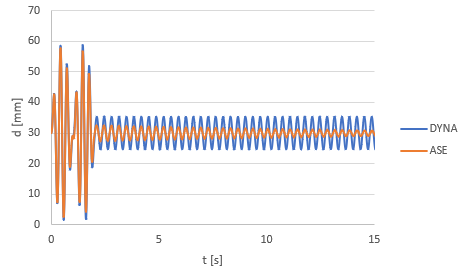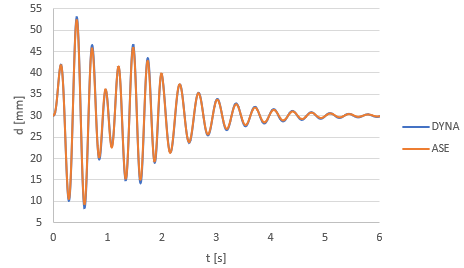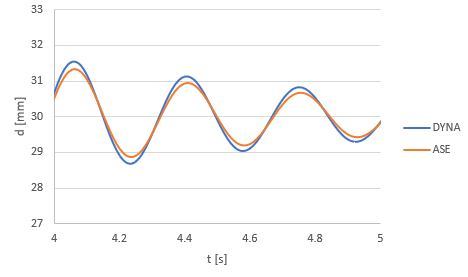Hello,
I was testing the results of 1 dof system with DYNA and ASE, and I found that ASE inserts damping in my model:

It must be a parameter that I did not consider…
This is the Teddy code:
+PROG TEMPLATE urs:4
HEAD Variables
$ Self weight [t]:
STO#M_PP 10
$ Dead load [t]:
STO#M_CM 20
$ Stiffness [kN/m]:
STO#K 1E4
$ Damping coefficient [%]
STO#nu 0
END
+PROG TEMPLATE urs:5
head
$ Angular frequency undamped system [rad/s]:
STO#omega SQR(#K*1E3/((#M_PP+#M_CM)*1E3))
$ Frequency undamped system [Hz]:
STO#f #omega/(2*#PI)
$ Critical damping [kg/s]:
STO#c_cri 2*(#M_PP+#M_CM)*1e3*#omega
$ Critical damping [kN·s/m]:
STO#c_cri_s #c_cri*1e-3
$ Damping [kg/s]:
STO#C #nu/100*#c_cri
$ Damping [kN·s/m]:
STO#C_s #C*1e-3
end
+prog template urs:10
head Harmonic load
$ Amplitude [kN]:
sto#p0_10 100
$ Period [s]:
sto#Tp_10 1.0*(0.75/#f)
end
+PROG SOFIMSHa urs:1
head
SYST TYPE 3D GDIV 100 GDIR POSZ
NODE NO 1 FIX ZP
MASS NO 1 MX #M_PP[t]
$NODE NO 2 FIX PPMM Z 1
SPRI NO 1 NA 1 DZ 1 CP #K
if #nu<>0
SPRI NO 2 NA 1 DZ 1 DP #C_s
endif
end
+PROG SOFILOAD urs:2
head Cargas muertas
LC NO 2 TITL 'Dead load'
NODE NO 1 TYPE PG P1 #M_CM*10
end
+prog sofiload urs:11
head Dynamic Load
lc 30 titl 'Sine-wave impulse'
node 1 type pz p1 #p0_10
func t #Tp_10 f 1.0 t1 0.0 TMAX 2.0
end
+PROG ASE urs:3
head
LC 1 dlz 1 titl 'Self weight'
LC 2
LC 5 dlz 1 titl 'Permanent loads'
LCC 2
end
+PROG DYNA urs:8
HEAD
ctrl rlc 1001 1+2+4
mass 0
mass lc 2 prz 100 mx 1
STEP 3000 30/3000 - -
LC 30;
hist U-Z 1 1 RESU PRIN LCST 90
END
+PROG ASE urs:7
HEAD
STEP N 3000 DT 1/100 LCST 2001 SELE 1+64 LCSM 10001
SYST PLC 5
MASS 0
MASS LC 2 PRZ 100 $MX 1
LC 102 DLZ 1
$ LCC 2
LCC 30
END
+PROG DYNR urs:9
HEAD Displacement history
HIST 90 U-Z 1
end
